
This edition of Directions in Highway Safety, GHSA's member newsletter, features details on the Infrastructure Investment and Jobs Act (IIJA), updates from NHTSA, details on the year’s grant programs, award-winners and so much more.
Quick Links: Cover Story | Executive Director's Report | From Washington | State of the States | Did You Know? | From Our Perspective
Bipartisan Infrastructure Boom for Safety!
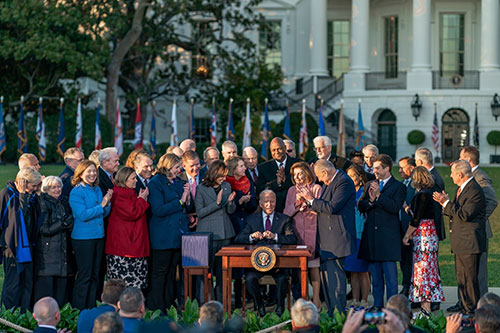 After months of negotiations, Congress reached an agreement on November 6 that resulted in the passage of a $500 billion transportation reauthorization bill, the Infrastructure Investment and Jobs Act (IIJA). With traffic fatalities increasing to historic highs, GHSA is excited for the new safety investment and the program reforms included in the bill.
After months of negotiations, Congress reached an agreement on November 6 that resulted in the passage of a $500 billion transportation reauthorization bill, the Infrastructure Investment and Jobs Act (IIJA). With traffic fatalities increasing to historic highs, GHSA is excited for the new safety investment and the program reforms included in the bill.
Congress reauthorized federal transportation programs for the next five years (Federal Fiscal Years 2022-2026). The bill immediately provides resources to combat leading highway safety threats such as speeding, impaired driving and not buckling up. The National Highway Traffic Safety Administration’s (NHTSA) current State and Community Highway Safety Grant Program (Section 402) and National Priority Safety Program (Section 405) will increase approximately 5% beginning in FFY 2022 and that will continue throughout the authorization period.
Over the past three years, GHSA steadfastly engaged with partners and Congress to advocate for a range of federal safety policy changes. Most of the changes for NHTSA’s grants will take effect beginning with the FFY 2024 Highway Safety Plan (HSP). One eagerly awaited change is moving from an annual highway safety planning cycle to a triennial one. As a result, state HSPs will detail how many federal grant funds will be used over a three-year period to address critical safety problems. States will submit smaller annual applications to NHTSA with specific grant and project information in years two and three.
Within the Section 405 program, Congress eliminated the Graduated Driver Licensing grant (405(g)), which has never been awarded to any state. Congress used those monies to create two new grants – one funds programs to prevent roadside deaths (405(h)) and the other (405(i)) funds programs to train police officers and drivers on traffic stop procedures. Throughout the Section 405 programs, Congress increased grant eligibility and expanded how funds can be spent on safety efforts, notably to better address multi-substance impaired driving, distracted driving, nonmotorized safety and traffic records programs.
The bill also takes steps toward achieving greater equity in highway safety. States will increase public participation and community collaboration in highway safety planning, especially for traffic enforcement efforts. Congress also increased funding and made reforms to increase state eligibility for the Section 1906 Grant Program to Prohibit Racial Profiling, which supports traffic stop data collection and analysis.
The IIJA creates novel competitive federal grant opportunities, including new, separate state grants for crash data modernization and vehicle recall awareness programs. Congress also created the Safe Streets and Roads for All Grant Program, which will provide $1.2 billion per year in competitive grants for local communities to implement Vision Zero programs.
Finally, Congress integrated into the bill the HALT/RIDE Act, which directs NHTSA to issue a new rulemaking to require passive impairment detection technology as standard equipment in passenger vehicles. The safety community expects this technology to revolutionize the prevention of impaired driving. This provision follows on the heels of other NHTSA safety rulemaking mandates that include back seat safety reminders, keyless ignitions, pedestrian safety and advanced driver assistance features.
The changes described here are only the highlights. The reauthorization bill includes many additional policy details that will improve road safety. GHSA and our safety partners will now collaborate with U.S. DOT and NHTSA to implement the reauthorization bill and begin the next chapter in highway safety.

 The holiday season is in full swing here in Washington, D.C. As we close out 2021 and prepare for the arrival of the new year, GHSA remains focused on addressing safety on our nation’s roadways.
The holiday season is in full swing here in Washington, D.C. As we close out 2021 and prepare for the arrival of the new year, GHSA remains focused on addressing safety on our nation’s roadways.
One of the big traffic safety highlights of the year was enacting the Infrastructure Investment and Jobs Act, which the president signed into law at a bipartisan ceremony held at the White House on November 15. This is a major win for all of us in traffic safety, as it provides an infusion of funding for behavioral safety, while also streamlining the implementation of federal and state safety programs across the country.
I’d like to recognize GHSA Senior Director of Policy and Government Relations Russ Martin for his incredible work on this effort. Working in collaboration with many key partners, Russ was instrumental in helping to secure the inclusion of numerous State Highway Safety Office (SHSO) priorities in this historic investment in highway safety programs, as outlined in the cover story of this issue of Directions. Thanks to Russ’s hard work, planning and coordination, states will have more resources and greater flexibility under this law as they work to address the surge in traffic deaths resulting from an increase in dangerous driving behavior during the pandemic.
One major piece of the bill I’d like to highlight is the HALT/RIDE Act, which GHSA and other traffic safety organizations have strongly supported. This provision will strengthen road safety through the prevention of future drunk driving incidents before they can occur and is a long-awaited victory in our quest to end impaired driving once and for all.
While the IIJA certainly merits plenty of attention, I also want to take this opportunity to highlight several key partnerships that, despite the pandemic, continue to flourish and provide grant opportunities to the states.
This summer, GHSA and Ford Motor Company Fund relaunched free, in-person teen driver safety trainings through the award-winning Ford Driving Skills for Life program. The fall 2021 tour launched in California and then traveled to Georgia, Tennessee and Texas, before wrapping up in Arizona. These sessions, which were subject to increased health and safety protocols, were extremely popular with teens and parents alike. In fact, one father-daughter duo traveled from Atlanta to Tempe to take advantage of the training.
In partnership with Ford, we also awarded grants to Kentucky, Michigan, Montana, New York, Tennessee and Utah to create and implement programs to combat teen speeding, a leading cause of crashes and fatalities. In October, during National Teen Driver Safety Week, we partnered with Ford to reinforce the vital role parents play in the learning to drive process by offering recommendations to help them help their novice drivers develop critical skills.
GHSA also announced the fourth year of our annual state grant program to help prevent impaired driving during the holiday season, powered by Uber. We awarded grants and Uber ride credits to Colorado, Connecticut, Maryland, New Mexico and Texas to conduct campaigns encouraging those who consume alcohol or other impairing substances to use ride-hailing as an alternative to getting behind the wheel. There was an overwhelmingly positive response when Maryland and Connecticut launched their campaigns on Thanksgiving eve, which speaks to the importance of this program as more people are out and about this holiday season. Stay tuned for more updates on our website and social media channels.
As I look back at what we’ve accomplished over the past year, I’m excited for what’s to come in 2022. Here’s to a safe and healthy new year!
Welcome New Members
GHSA is pleased to welcome the following new Associate Members. Click below to learn about their mission and services:
Join us in welcoming back Toyota, Davis Injury Lawyers and Stratacomm, who had previously been GHSA Associate Members.
GHSA welcomed a total of 49 new Associate Members in 2021. To learn more about all our Associate Members and to take advantage of their products and/or services, visit our website.

Skyrocketing Traffic Fatalities Prompt Development of National Strategy
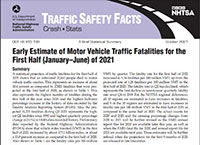 On October 21, NHTSA announced its early estimate of motor vehicle fatalities for the first half of 2021, projecting an estimated 20,160 Americans killed on our roads. That is an 18.4% increase over the same period in 2020 and the largest six-month increase ever recorded in the 46-year history of federal traffic safety record-keeping. This estimate also puts 2021 on track to be a year in which national roadway fatalities will exceed 40,000 for the first time since 2007.
On October 21, NHTSA announced its early estimate of motor vehicle fatalities for the first half of 2021, projecting an estimated 20,160 Americans killed on our roads. That is an 18.4% increase over the same period in 2020 and the largest six-month increase ever recorded in the 46-year history of federal traffic safety record-keeping. This estimate also puts 2021 on track to be a year in which national roadway fatalities will exceed 40,000 for the first time since 2007.
In response to this troubling trend, the U.S. Department of Transportation (U.S. DOT) announced the development of a National Roadway Safety Strategy, which will be released in early 2022. The strategy is expected to be multi-modal, inter-governmental and organized around the Safe System approach. GHSA, and many of our safety partners, participated in expert listening sessions and contributed to the development of this strategy. To promote the integral role of behavioral safety in the Safe System approach, earlier this week GHSA released a new report offering specific and practical recommendations for SHSOs, GHSA and our partners. You can access the report on the GHSA website.
Regulatory Revisions Ahead, New NHTSA Administrator and the Latest on Buy America
The federal transportation reauthorization contains numerous policy changes for NHTSA’s highway safety grant programs. Between now and when states begin to prepare their FFY 2024 HSPs, NHTSA must translate these changes into new regulations to govern how states apply for and use federal grants. GHSA is already preparing our suggestions for regulatory changes that include:
- Calling for NHTSA oversight that focuses more on programs, rather than projects.
- Differentiating the contents of triennial HSPs, Annual Applications and Annual Reports.
- Reducing or eliminating ambiguities in program rules.
- Clarifying how states can meet various grant requirements, including those created by the new transportation reauthorization.
We plan to collaborate with NHTSA to set up a sensible ruleset, so that our members and the agency can focus less on administrative issues and more on implementing lifesaving programs.
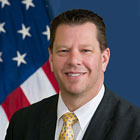 The Biden administration announced its nomination of Dr. Steven Cliff to be the next NHTSA Administrator. Dr. Cliff currently serves as the agency’s Acting Administrator and brings extensive scientific and regulatory experience to this role. NHTSA has lacked a Senate-confirmed Administrator for the past five years. GHSA, and many within the safety community, have called upon the White House to fully staff up the federal government’s safety-critical agencies.
The Biden administration announced its nomination of Dr. Steven Cliff to be the next NHTSA Administrator. Dr. Cliff currently serves as the agency’s Acting Administrator and brings extensive scientific and regulatory experience to this role. NHTSA has lacked a Senate-confirmed Administrator for the past five years. GHSA, and many within the safety community, have called upon the White House to fully staff up the federal government’s safety-critical agencies.
Earlier this year, the White House issued Executive Order 14005 to advance federal domestic purchasing preferences. The U.S. Office of Management and Budget (OMB) led a government-wide effort to review Buy America policies and practices throughout the year. Like all U.S. DOT modal agencies, NHTSA has its own Buy America policies for purchases made using federal grant funds. Though NHTSA has confirmed that the current Buy America rules continue to apply, GHSA will continue monitoring it for any changes.

A Season for Success!
GHSA continues to offer SHSOs a variety of grant opportunities. In 2021, we awarded 16 grants to support state efforts to address impaired driving and speeding. Throughout the year, GHSA’s External Engagement team worked to improve the grant process for states, including transitioning to an online reporting form and working more closely with the selected states to promote their grant programs through social media.
The Ford Motor Company Fund and GHSA partnered to award SHSOs in Kentucky, Michigan, Montana, New York, Tennessee and Utah grants totaling $135,000 to create and implement programs to help address teen speeding. Through GHSA’s partnership with Responsibility.org, $157,000 in grants were awarded to SHSOs in Georgia, Louisiana, Maryland and Wisconsin to address impaired driving through training and/or the implementation of recommendations in GHSA’s report, High-Risk Impaired Drivers: Combating a Critical Threat.
Additionally, from July through September the Maryland Highway Safety Office (MHSO) used a $100,000 grant provided by GHSA, the Insurance Institute for Highway Safety (IIHS) and the National Road Safety Foundation to conduct the first of two state speed management pilot projects on a rural corridor along the Eastern Shore. The MHSO partnered with the State Highway Administration, State Police and Worcester County Sheriff’s Office, to deploy low-cost engineering countermeasures along with speed enforcement and public outreach and education to slow motorists down. The pilot is being evaluated by IIHS and the results will be announced in early 2022.
And we wrapped up the year by partnering with Uber to award cash grants and ride credits to SHSOs in Colorado, Connecticut, Maryland, New Mexico and Texas to encourage the public to not drive after consuming alcohol or another impairing substance. Learn more about each state’s campaign on the GHSA website.
In 2022, GHSA will again collaborate with Responsibility.org to award grants to help states combat high-risk and multi-substance impaired driving. SHSOs will also have the opportunity to apply for grants to promote ride-hailing as a safe alternative to driving impaired, as well as grants addressing several other safety issues. Stay tuned for more information!
Showcases: A Resource for the States
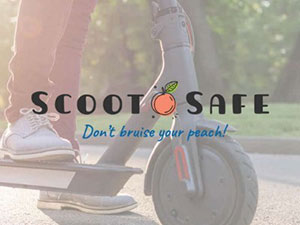 SHSOs are doing a lot of great work to address traffic safety and save lives by focusing on the most dangerous roadway behaviors in creative ways. GHSA is proud to promote the excellent work of SHSOs on our State Highway Safety Showcase website. This site is a resource for states, their partners and other traffic safety organizations looking for impactful ideas and new ways to improve roadway safety.
SHSOs are doing a lot of great work to address traffic safety and save lives by focusing on the most dangerous roadway behaviors in creative ways. GHSA is proud to promote the excellent work of SHSOs on our State Highway Safety Showcase website. This site is a resource for states, their partners and other traffic safety organizations looking for impactful ideas and new ways to improve roadway safety.
On the Showcase site, you can learn about how the Georgia Governor’s Office of Highway Safety partnered with Shepherd Center to create Scoot Safe, the country’s first federally funded e-scooter safety campaign. This partnership between highway safety and brain trauma experts led to the creation of a safe scooting checklist that cities and municipalities can customize and share with riders, as well as a series of short videos highlighting several important aspects of e-scooter safety.
Additional Showcases feature the results of holiday ride-hailing programs conducted in Colorado, Illinois, North Carolina, New Mexico and Texas using Lyft grants. Read these success stories to explore how states utilized GHSA’s partnership with Lyft to provide residents a safe and convenient alternative to driving impaired during the holiday season, a time of year when drunk and drugged driving crashes traditionally spike. We hope these examples will spur more programs to promote ride-hailing, which research shows effectively reduces impaired driving fatalities and severe injuries.
If your SHSO is interested in sharing program successes and best practices on GHSA’s website, you can submit details about the program by completing the online form.


Mark your calendars now and join GHSA at our 2022 Annual Meeting in Louisville, Kentucky, September 17-21. Work is underway to identify thought-provoking general sessions and workshop topics to help highway safety professionals reverse the uptick in roadway fatalities. We’re also excited to announce that sponsorship opportunities are now available and pleased to already welcome many long-time partners as well as several new ones as 2022 Highway Safety Champions. To learn more about sponsorship, visit our website.
Fred Manocherian Accepts James J. Howard Highway Safety Trailblazer Award
Fred Manocherian, who was honored at the GHSA 2021 Annual Meeting but was unable to travel to Denver, received his James J. Howard Highway Safety Trailblazer Award at the GHSA Executive Board meeting in New York City last week. Mr. Manocherian is a pioneering and relentless national advocate for highway safety, having founded the National Road Safety Foundation (NRSF) nearly 60 years ago. More information on the award and Mr. Manocherian can be found on the GHSA website.
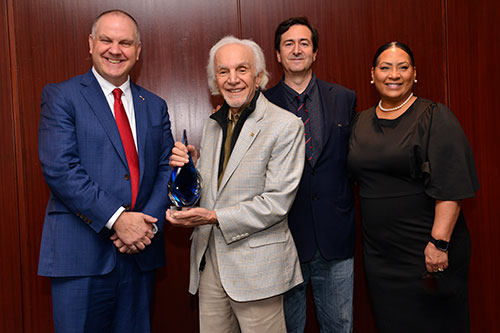
Pictured (l to r): GHSA Chair Chuck DeWeese, Fred Manocherian, son
John Manocherian and NRSF Director of Operations Michelle Anderson
Mark Ezzell Awarded the Kevin E. Quinlan Award from Responsibility.org
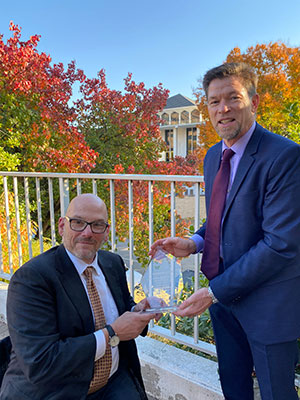
Mark Ezzell, Director of the North Carolina Governor’s Highway Safety Program and a member of the GHSA Executive Board, received the Responsibility.org Kevin E. Quinlan Award last month. This prestigious honor is reserved for individuals who have demonstrated both commitment and passion for reducing impaired driving and saving lives.
Mark brought together a team of traffic safety leaders and legislators in North Carolina to develop recommendations for a modernized ignition interlock law. Through his efforts, Senate Bill 183, which will allow offenders to have the ignition interlock installed on their vehicle immediately, was signed into law by the Governor on November 18 and goes into effect this month. The law also removes restrictions on when and where an offender can drive, provides opportunities to reduce the cost for the device if the offender demonstrates they are experiencing financial hardship and creates a study commission to research expanded uses and supervision for ignition interlocks.
GHSA appreciates Mark’s dedication to advancing traffic safety and ending impaired driving and congratulates him on receiving this well-deserved recognition.
Pictured (l to r): Mark Ezzell, Director, North
Carolina Governor's Highway Safety Program
and Chris Konschak, Senior Director of Traffic
Safety and Government Relations, Responsibility.org
Dynamic Speed Feedback Signs Can Get Drivers to Slow Down
The results of a new NHTSA study, conducted through the National Cooperative Research and Evaluation Program (NCREP), confirmed that when you show a driver how fast they are going over the posted speed limit, they are likely to slow down. Using Dynamic Speed Feedback Signs in a variety of contexts and locations, researchers found that in all cases, vehicle speeds decreased, leading them to conclude that the signs can be an effective tool for saving lives.
A two-page Traffic Tech summary is available online. The full report, Effectiveness of Dynamic Speed Feedback Signs, Vol. 1: Literature Review and Meta-Analysis, and the Vol. 2: Appendices and Annotated Bibliography is available for download.
Learn more about this and other BTSCRP research projects on our website.
Member Spotlight
GHSA appreciates the support of our Associate Members, who are committed to working with us to achieve a zero fatalities goal. This month, we’re featuring State Farm’s Jon Hull and Darrin Grondel with the National Alliance to Stop Impaired Driving (NASID).
Want to be featured in the next issue of Directions? Email Kerry Chausmer.
Impaired Driving Toxicology Best Practices
On December 14, GHSA hosted a webinar moderated by Russ Martin, Senior Director of Policy and Government Relations, with panelists Jennifer Limoges from the New York State Police Forensic Investigation Center; Robert Duckworth, Director of the Indiana Highway Safety Office located within the Indiana Criminal Justice Institute; and Amy Miles with the Forensic Toxicology Program at the Wisconsin State Laboratory of Hygiene. Panelists spoke about the new proposed national standards for forensic toxicology laboratories, Responsibility.org's new National Resource Toxicology Program and the recently established National Alliance to Stop Impaired Driving Coalition, and Indiana’s oral fluid testing grant program. If you missed this informative session, be sure to check it out online.
The National Road Safety Foundation Drive2Life PSA Contest for Teens
GHSA, the National Road Safety Foundation (NRSF) and Young Minds Inspired (YMI) have teamed up to encourage youth, teens and young adults to help spread the message that safe driving, walking and bicycling saves lives.
“Drivers, pedestrians and bicyclists have a responsibility to always be aware of their surroundings and not be distracted as they travel,” said Michelle Anderson of the NRSF, a long-time GHSA partner and nonprofit organization that promotes safe driving behavior. “Cell phones and earbuds have contributed to the increase in pedestrian and bicyclist casualties, so it’s important that all road users not be distracted. That’s the message we’re asking young people to help us communicate through the Drive2Life PSA Contest.”
From January 17 until March 21, 2022, individuals are encouraged to submit a script or written description of a 30-second television public service announcement (PSA) that warns drivers, pedestrians and cyclists to be careful when sharing the road. The winner will receive a $2,000 prize and a chance to work with an Emmy Award-winning producer to turn their idea into a PSA that will air on more than 170 television stations.
GHSA members are encouraged to help spread the word about the contest through outreach to schools, community-based groups and other youth-focused organizations. Full contest details can be found on the NRSF website.

Addressing Transportation Challenges in the Infrastructure Investment and Jobs Act
 Megan Foster
Megan Foster
Director of Federal Relations
AAA
For more than a century, AAA has been committed to advancing safe mobility. From assisting stranded motorists and pioneering drivers’ education, to creating the School Safety Patrol program and advocating for the creation of the Interstate Highway System, AAA has been at the forefront of traffic safety advocacy.
Consistent with this tradition, AAA supported the passage of the Infrastructure Investment and Jobs Act (IIJA) and worked to ensure key safety and funding provisions were included. AAA believes that the IIJA provides the necessary near-term funding to improve the nation’s transportation system. Still, policymakers must continue to look for ways to address the long-term solvency of the Highway Trust Fund and ensure federal funds are directed to the most effective projects and programs to improve mobility, accessibility and safety for all road and transit users. That is why AAA advocated to include the National Motor Vehicle Per-Mile User Fee Pilot, which will establish a new pilot program to develop and test a national road usage charge system. A program like this is critical to exploring road usage charging and other financing mechanisms as possible longer-term replacements to the federal gas tax.
AAA worked with GHSA and other national safety organizations to ensure the IIJA included increased federal safety grant funding to states, as well as reforms to improve grant program effectiveness and encourage more applicants. AAA also joined with safety organizations to advocate for the inclusion of the Multiple Substance Impaired Driving Prevention Act, which will increase investment in technologies for detecting multiple substance impairment when drivers are under the influence of alcohol and other drugs and improve reporting.
The historic investments included in the IIJA will help to address today’s transportation challenges, but the bill also provides an opportunity to invest in the future. For example, AAA supported the inclusion of $7.5 billion to build out electric vehicle charging and alternative fueling infrastructure. AAA also supported language to modernize the New Car Assessment Program (NCAP), implement a rating system for crash-avoidance technologies, and require NHTSA to publish a biannual roadmap detailing additional efforts to improve NCAP. Additionally, AAA successfully advocated for language in the IIJA directing the U.S. Department of Transportation to issue a rule updating performance standards for vehicle headlamp systems and allow for adaptive driving beam headlamps within two years.
AAA will continue to work with GHSA and others on initiatives to improve and modernize our nation’s transportation infrastructure and increase safety mobility for all. We look forward to continuing AAA’s long-standing relationships with State Highway Safety Offices when it comes to implementing these much-needed investments to meet our future transportation needs.


